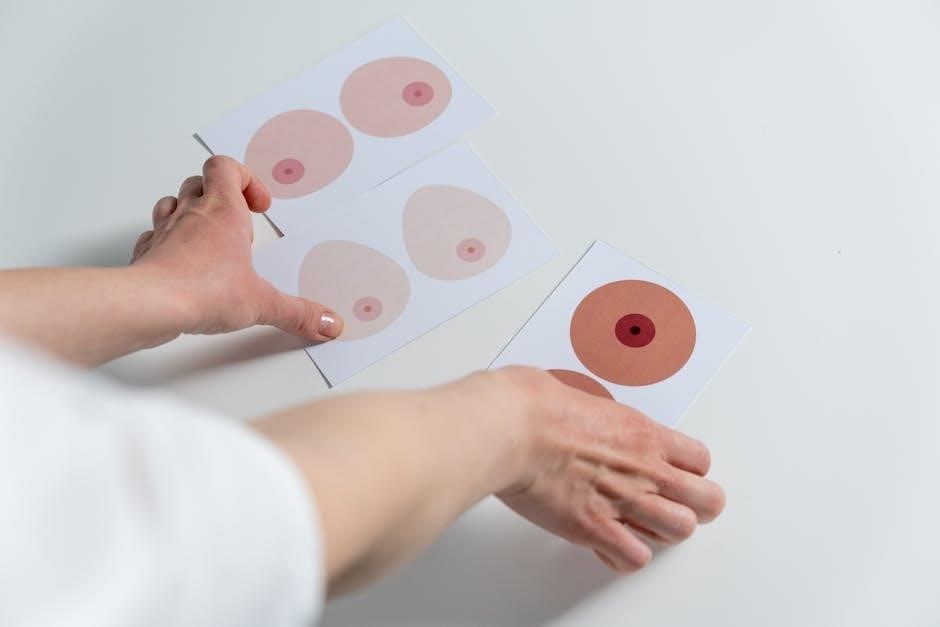emd protocol cards v13 pdf

The EMD Protocol Cards v13 are a set of guidelines for emergency medical technicians (EMTs)‚ providing step-by-step instructions for managing medical emergencies. Version 13 introduces improved protocols and updated procedures‚ ensuring effective emergency response and integration with the Medical Priority Dispatch System (MPDS).
1.1 What Are EMD Protocol Cards?
The EMD Protocol Cards are a set of standardized reference tools designed for emergency medical dispatchers (EMDs) and technicians (EMTs). These cards provide concise‚ step-by-step guidance for managing various medical emergencies‚ ensuring quick and accurate decision-making. Each card focuses on specific emergency scenarios‚ such as trauma‚ cardiac issues‚ or respiratory distress‚ offering clear protocols for assessment‚ treatment‚ and patient care. They are portable‚ easy to navigate‚ and designed to be used in high-stress environments. By standardizing emergency response procedures‚ the cards help ensure consistency and effectiveness in critical situations. The v13 update enhances these tools with updated guidelines and improved functionality‚ making them indispensable for modern emergency medical services (EMS) professionals.
1.2 Purpose of the EMD Protocol Cards v13
The primary purpose of the EMD Protocol Cards v13 is to provide emergency medical dispatchers (EMDs) and technicians (EMTs) with a standardized‚ quick-reference guide for managing medical emergencies. These cards are designed to ensure that responders can rapidly identify the nature of an emergency and apply the most appropriate protocols. By standardizing emergency response procedures‚ the cards help reduce errors and improve patient outcomes. They also serve as a training tool‚ reinforcing best practices and compliance with medical dispatch standards. The v13 update further enhances this purpose by incorporating the latest medical advancements and integrating seamlessly with the Medical Priority Dispatch System (MPDS)‚ ensuring a coordinated and effective emergency response.
1.3 Importance of the v13 Update
The v13 update of the EMD Protocol Cards is crucial as it introduces significant improvements to emergency medical dispatch protocols. This version incorporates the latest medical advancements‚ ensuring that EMDs and EMTs have access to the most current and effective guidelines. The update includes new protocols for specific emergencies‚ such as headaches and pregnancy-related issues‚ enhancing the ability to handle diverse situations. Additionally‚ v13 improves integration with the Medical Priority Dispatch System (MPDS)‚ streamlining emergency response processes. These enhancements ensure better patient outcomes‚ reduce response errors‚ and align with evolving medical standards. The v13 update is essential for maintaining a high level of preparedness and efficiency in emergency medical services.

Features of the EMD Protocol Cards v13
The EMD Protocol Cards v13 offer a comprehensive set of guidelines for emergency response. Features include improved protocols‚ enhanced emergency response guidelines‚ and expanded medical emergency protocols. The user-friendly design ensures quick access to critical information‚ making it an essential tool for EMTs.
2.1 Improvements in the v13 Version
- The v13 update introduces enhanced protocol clarity‚ ensuring EMTs can quickly access critical information during emergencies.
- Updated procedures reflect the latest medical advancements‚ improving response accuracy and patient outcomes.
- Expanded protocols address a broader range of medical scenarios‚ including specific guidelines for conditions like headaches and pregnancy.
- Improved integration with the Medical Priority Dispatch System (MPDS) enhances emergency dispatch efficiency.
- A user-friendly format and design make the cards easier to navigate‚ reducing response times in high-pressure situations.
- Customization options allow agencies to tailor protocols to their specific needs using software like Adobe Acrobat;
These improvements ensure the EMD Protocol Cards v13 remain a vital tool for emergency medical response.
2.2 Enhanced Emergency Response Guidelines
The EMD Protocol Cards v13 include enhanced emergency response guidelines that provide EMTs with clear‚ actionable steps for various medical scenarios. These guidelines ensure rapid and accurate decision-making‚ improving patient outcomes. They cover critical situations such as chest pain‚ trauma‚ and respiratory distress‚ offering specific instructions for assessment and intervention. The updated protocols emphasize the importance of prioritizing life-threatening conditions and streamline communication between dispatchers and responders. By integrating with the Medical Priority Dispatch System (MPDS)‚ the guidelines ensure a coordinated emergency response. These enhancements enable EMTs to deliver care more effectively‚ reducing errors and improving response times in high-stress situations. The updated guidelines also include expanded protocols for less common emergencies‚ ensuring comprehensive coverage of medical scenarios. This ensures EMTs are well-prepared to handle diverse emergency situations with confidence and precision.
2.3 Expanded Medical Emergency Protocols
The EMD Protocol Cards v13 feature expanded medical emergency protocols‚ providing comprehensive guidance for a wider range of medical scenarios. These updates include detailed instructions for managing conditions such as headaches‚ pregnancy-related emergencies‚ and fainting episodes. Protocol 18 specifically addresses headaches‚ while Protocol 24 focuses on pregnancy-related issues‚ ensuring EMTs are equipped to handle these situations effectively. The expanded protocols also cover high-priority conditions like suspected aortic aneurysms and tearing pain‚ offering clear steps for assessment and intervention. This broader scope ensures that EMTs can respond confidently to diverse emergencies‚ from minor incidents to life-threatening situations. The updated protocols are designed to improve patient outcomes by providing precise‚ evidence-based care in every scenario.
2.4 User-Friendly Format and Design
The EMD Protocol Cards v13 are designed with a user-friendly format‚ ensuring easy navigation and quick access to critical information. The PDF format allows compatibility with various digital devices‚ making it accessible on smartphones‚ tablets‚ and computers. The cards feature a clear‚ organized layout with color-coded sections and concise instructions‚ reducing response times during emergencies. Quick reference guides and visual aids‚ such as flowcharts and checklists‚ enhance readability and usability. Customization options enable users to tailor the cards to their specific needs‚ while the portable design ensures they can be carried effortlessly. This intuitive format empowers EMTs to focus on patient care‚ knowing they have reliable‚ easy-to-follow protocols at their fingertips. The design prioritizes clarity and efficiency‚ making it an indispensable tool for emergency medical response.

How to Use EMD Protocol Cards v13
The EMD Protocol Cards v13 are designed for quick reference‚ providing EMTs with step-by-step instructions for emergencies. The user-friendly format allows easy navigation‚ ensuring rapid access to critical protocols. Digital compatibility enables use on smartphones and tablets‚ while customizable options tailor the cards to specific needs. Clear guidelines and visual aids help EMTs respond efficiently‚ making the cards an essential tool for emergency situations.
3.1 Step-by-Step Instructions for EMTs
The EMD Protocol Cards v13 provide EMTs with a structured approach to managing emergencies. Begin by assessing the situation and identifying the chief complaint. Next‚ use the protocol cards to determine the appropriate Medical Priority Dispatch System (MPDS) code. Assign a response priority based on the severity of the situation. Follow the step-by-step guidelines for specific emergencies‚ such as cardiac arrest or trauma. Ensure proper documentation of all actions taken. These instructions are designed to streamline decision-making‚ ensuring timely and effective care. The updated v13 version includes enhanced protocols for common emergencies‚ improving response accuracy and patient outcomes. Always refer to the quick reference guide for rapid access to critical information.
3.2 Navigation and Quick Reference Guide
The EMD Protocol Cards v13 feature an intuitive design with clear tabs and color-coded sections for easy navigation. A quick reference guide is included to help EMTs rapidly locate critical information during emergencies. The guide is organized by common chief complaints and provides direct access to relevant protocols. Key updates in v13 enhance readability‚ with bullet points and flowcharts simplifying complex procedures. Emergency medical technicians can quickly identify the appropriate MPDS code and associated response level using the reference guide. This streamlined approach ensures that EMTs can focus on patient care while efficiently navigating the protocols. The updated design reduces response time and improves accuracy in high-pressure situations‚ making it an indispensable tool for emergency medical services (EMS) professionals.
3.3 Application in Real-World Scenarios
The EMD Protocol Cards v13 are widely applied in real-world emergency situations‚ providing EMTs with actionable guidance for diverse medical crises. From trauma incidents to cardiac arrests‚ these cards offer step-by-step protocols that ensure timely and effective care. For example‚ in cases of chest pain‚ the cards outline assessment steps and treatment options‚ aligning with MPDS codes to prioritize response levels. Similarly‚ for allergic reactions or respiratory distress‚ EMTs can quickly reference specific interventions. Real-world application demonstrates that the updated v13 protocols reduce on-scene decision-making time and improve patient outcomes. Practical examples include rapid identification of stroke symptoms and appropriate transport decisions. This real-world applicability makes the EMD Protocol Cards v13 an essential resource for emergency medical services (EMS) professionals.

Technical Aspects of the EMD Protocol Cards v13 PDF
The EMD Protocol Cards v13 PDF ensures compatibility with digital devices‚ offering enhanced portability and accessibility. The PDF format allows for easy sharing and quick reference during emergencies. Features include customizable content‚ enabling EMTs to adapt protocols to specific needs. Adobe Acrobat or similar software is required for editing‚ ensuring updates and modifications remain straightforward. This format maintains clarity and organization‚ critical for rapid decision-making in high-pressure situations‚ while also preserving the integrity of medical guidelines and protocols.
4.1 Compatibility with Digital Devices
The EMD Protocol Cards v13 PDF is designed to be compatible with a wide range of digital devices‚ including smartphones‚ tablets‚ and laptops. This ensures that emergency medical technicians (EMTs) can access critical information quickly‚ regardless of the device they use. The PDF format allows for seamless viewing across platforms‚ with features like zoom and search enabling easy navigation. Additionally‚ the file can be stored on cloud storage services‚ providing remote access and ensuring availability in emergency situations. Compatibility with both iOS and Android devices makes it a versatile tool for modern emergency response systems. This adaptability enhances the efficiency of EMTs in real-world scenarios‚ where every second counts.
4.2 PDF Format Benefits for Emergency Response
The EMD Protocol Cards v13 PDF offers numerous benefits for emergency response situations. Its universal compatibility ensures that the document can be accessed on any device with a PDF viewer‚ eliminating platform-specific limitations. The PDF format retains the layout and formatting‚ guaranteeing consistency in critical information display. Additionally‚ PDFs are easily shareable via email or cloud storage‚ facilitating quick dissemination among emergency teams. The ability to password-protect the file enhances security‚ preventing unauthorized access. Furthermore‚ PDFs are resistant to viruses and tampering‚ ensuring data integrity. These features make the PDF format an ideal choice for storing and distributing emergency protocols‚ providing reliability and accessibility in high-stress environments. This ensures EMTs can rely on the information during critical moments‚ enhancing overall response efficiency and effectiveness.
4.3 Editing and Customization Options
The EMD Protocol Cards v13 PDF allows for limited editing and customization to meet specific organizational needs. Using software like Adobe Acrobat‚ users can add annotations‚ highlights‚ or additional notes to the document. This feature is particularly useful for EMTs who may need to tailor protocols to their agency’s procedures or local medical directives. Customization ensures that the protocols remain relevant and adaptable to evolving emergency medical practices. However‚ the core content of the protocols should remain unchanged to maintain compliance with established medical standards. This balance between flexibility and consistency makes the PDF format a practical tool for emergency response teams seeking to align the protocols with their operational requirements while preserving their integrity and effectiveness in critical situations.
4.4 Software Requirements for Viewing and Editing
To view the EMD Protocol Cards v13 PDF‚ a PDF reader such as Adobe Acrobat Reader or similar software is required. For editing‚ advanced tools like Adobe Acrobat Pro are necessary‚ enabling features like annotations and content modifications. The PDF format ensures compatibility across various devices‚ including desktops‚ tablets‚ and smartphones‚ making it accessible in emergency settings. While basic viewing is straightforward‚ editing requires specialized software to maintain the document’s integrity and functionality. Ensuring the correct software is available is crucial for effective utilization of the protocol cards in training and real-world applications.

Emergency Medical Dispatch (EMD) Protocols
EMD Protocols are structured guidelines that emergency dispatchers follow to assess and respond to medical emergencies. They integrate with the Medical Priority Dispatch System (MPDS) to prioritize calls effectively.
5.1 Overview of EMD Protocols
Emergency Medical Dispatch (EMD) protocols are standardized guidelines used by EMDs to prioritize and manage emergency calls effectively. These protocols ensure that callers receive appropriate care instructions while awaiting medical assistance. EMD protocols are integrated with the Medical Priority Dispatch System (MPDS)‚ enabling dispatchers to categorize emergencies based on severity and allocate resources efficiently. They cover a wide range of medical situations‚ from trauma and cardiac issues to obstetric emergencies. Specific protocols‚ such as those for headaches or pregnancy-related conditions‚ provide clear‚ step-by-step instructions. The EMD Protocol Cards v13 enhance these systems‚ offering updated and evidence-based practices to improve patient outcomes. These protocols are essential for maintaining consistency and quality in emergency medical dispatch worldwide.
5.2 Role of EMDs in Emergency Response Systems
Emergency Medical Dispatchers (EMDs) play a critical role in emergency response systems by serving as the first point of contact for individuals in need of medical assistance. Their primary responsibility is to quickly assess the severity of the situation and prioritize the urgency of the emergency. EMDs utilize the EMD Protocol Cards v13 to guide callers with specific instructions‚ ensuring that patients receive appropriate care while waiting for help to arrive. They are essential in dispatching the right resources and ensuring a timely response. By following established protocols‚ EMDs help maintain the integrity of emergency medical services‚ directly impacting patient outcomes. Their role is vital in coordinating effective emergency responses and providing life-saving guidance in critical situations.
5.3 Integration with MPDS (Medical Priority Dispatch System)
The EMD Protocol Cards v13 are seamlessly integrated with the Medical Priority Dispatch System (MPDS)‚ a globally recognized system for emergency dispatch. This integration ensures a standardized approach to prioritizing and managing medical emergencies. The MPDS categorizes emergencies based on severity‚ and the EMD Protocol Cards v13 provide corresponding step-by-step instructions for each category. This alignment enables EMDs to efficiently triage calls and dispatch resources appropriately. The updated version of the protocol cards includes enhancements that complement the MPDS‚ ensuring consistency and accuracy in emergency response. By working together‚ these systems improve response times and patient outcomes‚ making them indispensable tools in emergency medical services.
5.4 Specific Protocols for Common Emergencies
The EMD Protocol Cards v13 include detailed guidelines for managing common medical emergencies‚ such as chest pain‚ difficulty breathing‚ and allergic reactions. These protocols provide EMDs with clear‚ step-by-step instructions to assess and respond to emergencies effectively. For example‚ specific protocols address suspected aortic aneurysms‚ diagnosed aortic aneurysms‚ and fainting or near-fainting episodes. Each protocol is designed to help EMDs quickly identify the severity of the situation and provide appropriate care instructions. The cards also cover scenarios like headaches and pregnancy-related emergencies‚ ensuring comprehensive coverage of potential situations. By following these specific protocols‚ EMDs can deliver timely and accurate assistance‚ improving patient outcomes in critical situations.

Legal and Compliance Considerations
The EMD Protocol Cards v13 must comply with regulatory requirements and medical dispatch standards‚ ensuring adherence to legal and ethical guidelines during emergency response situations.
6;1 Regulatory Requirements for EMD Protocols
The EMD Protocol Cards v13 must comply with established regulatory standards for emergency medical dispatching. These standards ensure that protocols align with national and local medical guidelines‚ providing consistent and reliable emergency care. Compliance involves adherence to the Medical Priority Dispatch System (MPDS) and other recognized dispatch protocols. Training programs for EMDs must meet these regulatory requirements to maintain certification and ensure protocol accuracy. Failure to comply may result in legal or operational consequences. Regular updates‚ such as those in Version 13‚ help maintain alignment with evolving medical practices and legal standards.
6.2 Compliance with Medical Dispatch Standards
Compliance with medical dispatch standards is critical for ensuring the effectiveness of the EMD Protocol Cards v13. These protocols must align with internationally recognized standards‚ such as the Medical Priority Dispatch System (MPDS)‚ to guarantee consistent and accurate emergency responses. Regular audits and training programs are essential to maintain compliance‚ ensuring that EMDs adhere to established guidelines. Version 13 incorporates updates that reflect current medical practices‚ enhancing the reliability of dispatch protocols. Compliance also involves staying updated with legal and regulatory changes‚ ensuring that emergency responses remain within accepted standards of care. By adhering to these standards‚ the EMD Protocol Cards v13 provide a framework for efficient and ethical emergency medical dispatching.

Training and Resources for EMDs
Training programs for EMD Protocol Cards v13 include specialized courses and workshops‚ ensuring EMDs master the updated protocols. Online resources‚ such as manuals and guides‚ further support continuous learning and proficiency in emergency dispatching.
7.1 Training Programs for EMD Protocol Cards v13
Training programs for EMD Protocol Cards v13 are designed to ensure emergency medical dispatchers (EMDs) and technicians are well-versed in the updated protocols. These programs typically include comprehensive seminars‚ hands-on simulations‚ and online modules to cover the latest changes in emergency response. A key focus is on the integration of MPDS (Medical Priority Dispatch System) with the v13 protocols‚ ensuring seamless application in real-world scenarios. Additionally‚ training emphasizes critical thinking and decision-making skills‚ enabling EMDs to adapt protocols to diverse emergencies effectively. Regular updates and practical exercises help participants stay current with the evolving standards of emergency medical dispatch‚ ensuring consistent and reliable response practices.

7.2 Online Resources and Manuals
Various online resources and manuals are available to support the use of EMD Protocol Cards v13. Digital libraries and official websites provide access to downloadable PDF versions of the protocols‚ ensuring easy reference for emergency medical dispatchers (EMDs). These resources often include supplementary materials‚ such as quick reference guides and updated protocol summaries. Many educational institutions and medical organizations offer free or subscription-based access to these materials. Additionally‚ online forums and training platforms provide discussions and tutorials on implementing the v13 protocols effectively. These resources are essential for staying updated on the latest emergency response guidelines and ensuring compliance with industry standards. Regular updates and new editions are also announced through these online channels‚ making them a reliable source for EMD professionals;

Case Studies and Examples
Real-world applications of EMD Protocol Cards v13 demonstrate their effectiveness in emergency response. Case studies highlight specific protocols‚ such as Protocol 18 (Headache) and Protocol 24 (Pregnancy)‚ showcasing practical implementations and outcomes in real emergencies.
8.1 Real-World Applications of EMD Protocol Cards v13
The EMD Protocol Cards v13 have proven invaluable in real-world emergency scenarios‚ providing EMTs with clear‚ actionable guidance. For instance‚ in cases of chest pain or suspected heart attacks‚ the cards offer step-by-step instructions for assessment and prioritization‚ ensuring timely and appropriate care. Similarly‚ during traumatic injuries‚ such as vehicle accidents‚ the protocols enable quick decision-making to stabilize patients effectively. The integration of Protocol 18 (headache) and Protocol 24 (pregnancy) has been particularly beneficial in handling sensitive conditions. Real-world examples include a cardiac arrest case where the v13 update streamlined CPR instructions‚ and a multi-vehicle accident where the quick-reference format saved critical time. These applications highlight the practical impact of the v13 update in improving emergency response efficiency and patient outcomes.

Future Developments in EMD Protocols
Future updates to EMD protocols aim to enhance emergency response through advanced integration with real-time data systems‚ AI-driven insights‚ and expanded dynamic patient assessment guidelines‚ ensuring adherence to evolving global medical standards and optimizing care delivery and response times.
9.1 Expected Updates and Improvements
Future updates to the EMD Protocol Cards v13 are expected to incorporate advancements in medical research and technology. Enhancements may include expanded protocols for emerging medical conditions‚ integration with AI-driven diagnostic tools‚ and improved data-sharing capabilities. There is also potential for real-time updates to ensure EMTs have access to the most current guidelines during emergencies. Additionally‚ user feedback will likely influence design improvements‚ such as enhanced navigation and customizable layouts. These updates aim to further streamline emergency response processes and improve patient outcomes. By staying aligned with evolving medical standards‚ the EMD Protocol Cards will remain a critical resource for emergency medical technicians worldwide.